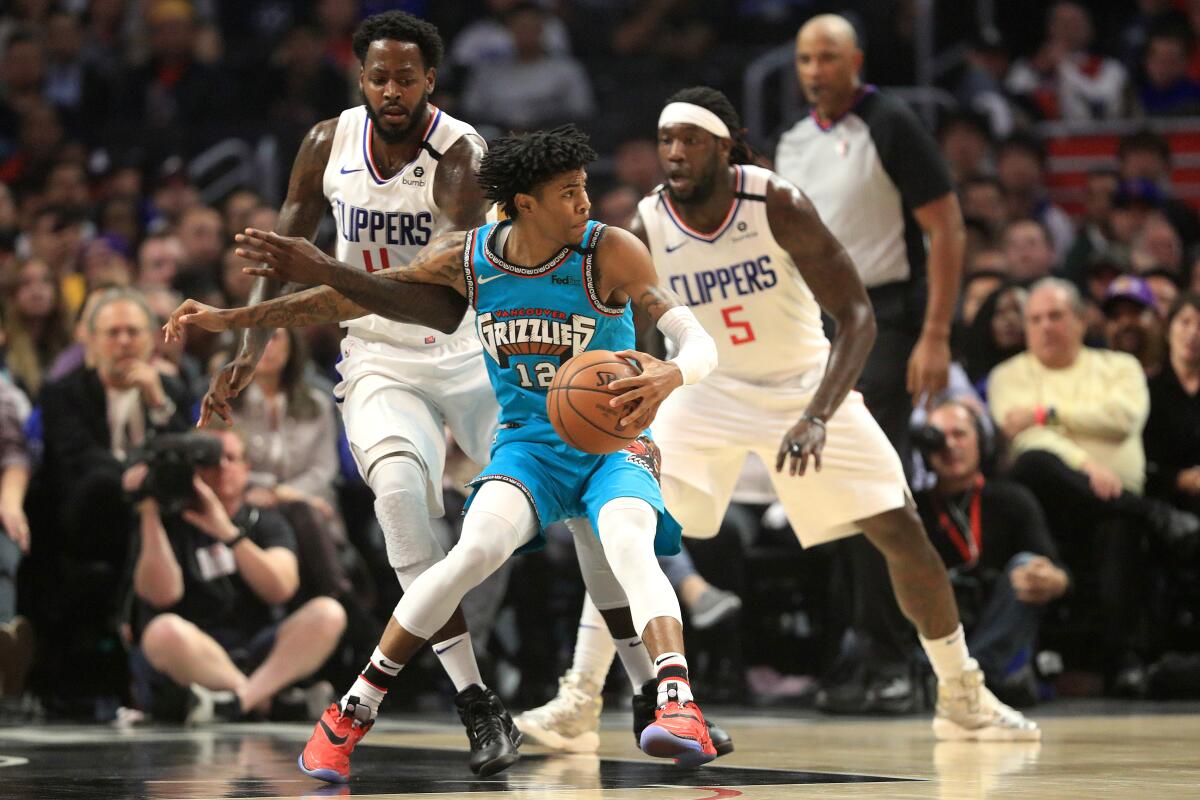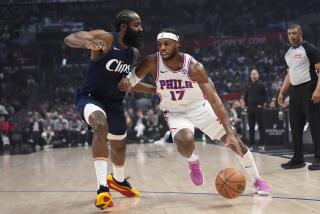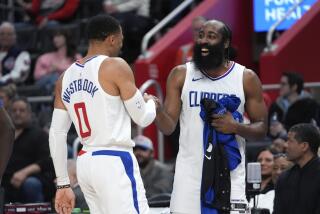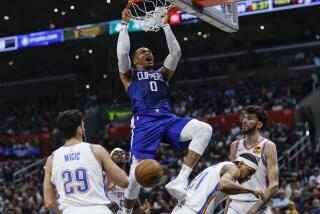Clippers confident about options against Rockets’ small-ball lineup

HOUSTON — When the Houston Rockets rid themselves of a traditional center one month ago and bet big on a commitment to going small, the Rockets invited skepticism across the NBA.
They also created headaches too.
Though opponents have questioned the postseason viability of playing a shorter lineup, many have succumbed to it just the same. Houston has gone 7-3 since trading center Clint Capela to Atlanta, adding 6-foot-8 wing Robert Covington, shifting 6-5 P.J. Tucker to Capela’s old position and stationing nearly all five players outside the three-point line.
The strategy is such an outlier it has thrown off many opponents who must decide how to match up with Houston.
The Clippers viewed their 109-94 victory Tuesday against Oklahoma City as an example of why they’re confident to play either on Houston’s terms or set their own Thursday at Toyota Center.
The Clippers’ starting lineup of 7-foot Ivica Zubac at center and a trio of 6-8 forwards — Kawhi Leonard, Paul George and Marcus Morris — outscored Oklahoma City by 10 points in nearly 13 minutes. In the second half, a front line of Morris at forward and 6-8 JaMychal Green at center immediately paid dividends as well.
Soon after he checked in to replace backup center Montrezl Harrell, Green screened for Lou Williams and slipped to the three-point line for a wide-open shot he made for a 19-point lead. Three minutes later, he made another three-pointer.
“The thing you like about this team is it can be a really big team and it can play small ball as well,” coach Doc Rivers said. “Our small-ball lineup is lethal, we just haven’t needed it much. It’s nice to be able to have both.”
Defensively, Green didn’t allow a field-goal attempt while guarding Thunder center Steven Adams, one of the strongest players in the NBA, during eight possessions. For the Clippers, it was a case study of why they believe removing Zubac and Harrell, their typical centers, in favor of more shooting doesn’t mean conceding toughness.
By effectively buying out MSG’s opposition Ballmer would clear a significant obstacle in the path of starting construction on a new arena for the Clippers.
Though Green has played center only 3% of the time this season, he calls it a “natural position” because he played it in college, overseas, in the NBA’s developmental league and during last season’s playoffs as part of a small-ball starting lineup against Golden State.
“[Green] is the strongest dude I’ve ever seen pound-for-pound — country strong,” guard Landry Shamet said.
Creating advantages out of shorter lineups has helped the Clippers before as they built the league’s highest-scoring bench around the 6-8 Harrell and guard Lou Williams. But whereas nearly 61% of Harrell’s field-goal attempts are taken within three feet of the basket, Green has made 36% of his three-pointers this season while shooting them from a career-long 25.3 feet. Morris, another forward Rivers would like to see play center in some lineups, has made nearly 42% of his three-pointers this season, though that number is down to 28% since being traded to the Clippers on Feb. 6
“I think that’s major because you put two rugged, tough guys that’s not going to back down,” Morris said. “At the end of the day it’s not really too many fives that score, back to the basket, in this league. So you spread them out. Now you got Kawhi, you got [Paul George] going to the rim and Lou going to the rim with no big down there to come in. I shoot 40% from the three, JaMychal shoot 40, you know what I mean? That’s a high-percentage shot for us.”
Small-ball lineups tailored around LeBron James helped Miami win championships and, more recently, Golden State’s “death lineups” pushed the possibilities further. Houston’s version has taken the concept to an extreme, with players taller than 6-8 used in only 29 minutes out of a possible 2,425 since Feb. 6, according to a FiveThirtyEight analysis. Since Covington joined Houston, 77% of his shots have come beyond the three-point line.
His former teachers remember Clippers star Kawhi Leonard just as he is now: quiet, focused and successful.
The shift has unlocked guard Russell Westbrook, in particular, who is averaging 33 points on 56% shooting in his last eight games. With driving lanes open, the career 30% three-point shooter is firing less often from long range while averaging a league-high 22 drives per game since Feb. 6.
The Rockets’ defense has not dipped since the switch though its rebounding has suffered at times. When the Knicks stuck to bigger lineups Monday, New York grabbed 31 more rebounds than Houston, with 7-foot center Mitchell Robinson collecting 13 rebounds in 24 minutes off the bench.
How the Clippers choose to combat the Rockets’ grand experiment remains to be seen, but Rivers has options.
“I just think you gotta be you,” Rivers said. “Houston plays their way and they’re going to win their way. We’re going to play our way and we’re going to win our way.”
UP NEXT
AT HOUSTON
When: 5 p.m. PST, Thursday
On the air: TV: Prime Ticket, TNT; Radio: 570
Update: The Clippers (42-19) are 1-2 this season against Houston (39-21), which is 21-8 at home and has won seven of its last eight at Toyota Center. Rockets guard James Harden is averaging a league-best 34.9 points this season and 37.3 points in three games against the Clippers.
More to Read
Get our high school sports newsletter
Prep Rally is devoted to the SoCal high school sports experience, bringing you scores, stories and a behind-the-scenes look at what makes prep sports so popular.
You may occasionally receive promotional content from the Los Angeles Times.







